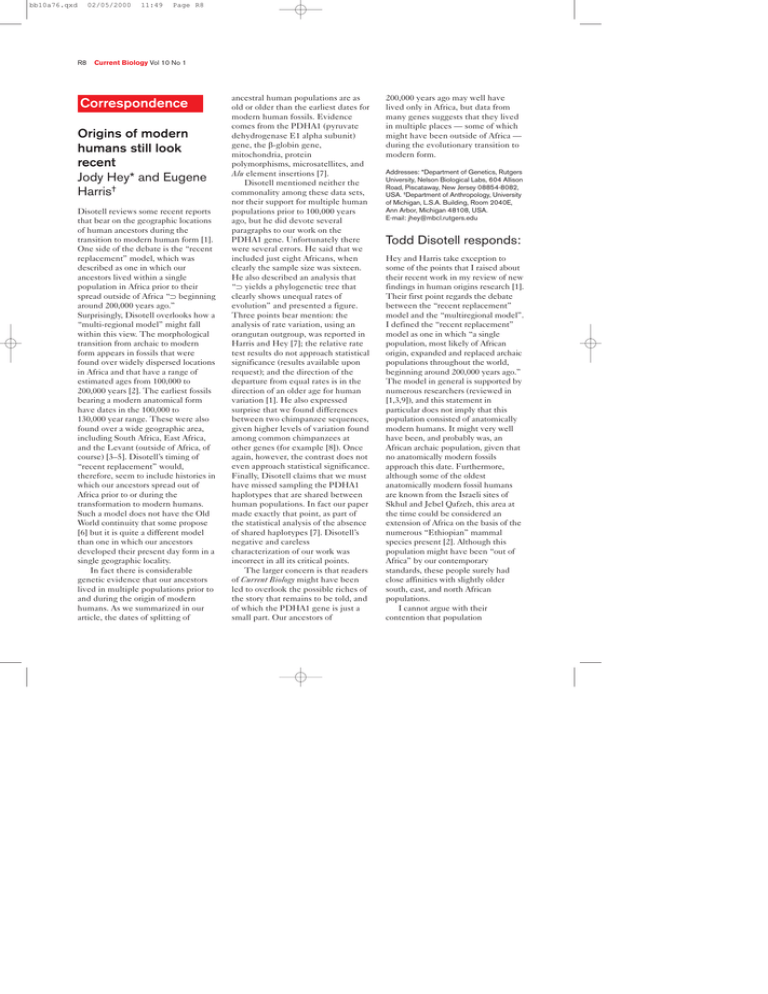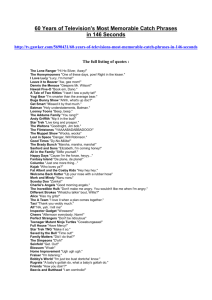Correspondence
advertisement

bb10a76.qxd 02/05/2000 R8 11:49 Page R8 Current Biology Vol 10 No 1 Correspondence Origins of modern humans still look recent Jody Hey* and Eugene Harris† Disotell reviews some recent reports that bear on the geographic locations of human ancestors during the transition to modern human form [1]. One side of the debate is the “recent replacement” model, which was described as one in which our ancestors lived within a single population in Africa prior to their spread outside of Africa “…beginning around 200,000 years ago.” Surprisingly, Disotell overlooks how a “multi-regional model” might fall within this view. The morphological transition from archaic to modern form appears in fossils that were found over widely dispersed locations in Africa and that have a range of estimated ages from 100,000 to 200,000 years [2]. The earliest fossils bearing a modern anatomical form have dates in the 100,000 to 130,000 year range. These were also found over a wide geographic area, including South Africa, East Africa, and the Levant (outside of Africa, of course) [3–5]. Disotell’s timing of “recent replacement” would, therefore, seem to include histories in which our ancestors spread out of Africa prior to or during the transformation to modern humans. Such a model does not have the Old World continuity that some propose [6] but it is quite a different model than one in which our ancestors developed their present day form in a single geographic locality. In fact there is considerable genetic evidence that our ancestors lived in multiple populations prior to and during the origin of modern humans. As we summarized in our article, the dates of splitting of ancestral human populations are as old or older than the earliest dates for modern human fossils. Evidence comes from the PDHA1 (pyruvate dehydrogenase E1 alpha subunit) gene, the β-globin gene, mitochondria, protein polymorphisms, microsatellites, and Alu element insertions [7]. Disotell mentioned neither the commonality among these data sets, nor their support for multiple human populations prior to 100,000 years ago, but he did devote several paragraphs to our work on the PDHA1 gene. Unfortunately there were several errors. He said that we included just eight Africans, when clearly the sample size was sixteen. He also described an analysis that “…yields a phylogenetic tree that clearly shows unequal rates of evolution” and presented a figure. Three points bear mention: the analysis of rate variation, using an orangutan outgroup, was reported in Harris and Hey [7]; the relative rate test results do not approach statistical significance (results available upon request); and the direction of the departure from equal rates is in the direction of an older age for human variation [1]. He also expressed surprise that we found differences between two chimpanzee sequences, given higher levels of variation found among common chimpanzees at other genes (for example [8]). Once again, however, the contrast does not even approach statistical significance. Finally, Disotell claims that we must have missed sampling the PDHA1 haplotypes that are shared between human populations. In fact our paper made exactly that point, as part of the statistical analysis of the absence of shared haplotypes [7]. Disotell’s negative and careless characterization of our work was incorrect in all its critical points. The larger concern is that readers of Current Biology might have been led to overlook the possible riches of the story that remains to be told, and of which the PDHA1 gene is just a small part. Our ancestors of 200,000 years ago may well have lived only in Africa, but data from many genes suggests that they lived in multiple places — some of which might have been outside of Africa — during the evolutionary transition to modern form. Addresses: *Department of Genetics, Rutgers University, Nelson Biological Labs, 604 Allison Road, Piscataway, New Jersey 08854-8082, USA. †Department of Anthropology, University of Michigan, L.S.A. Building, Room 2040E, Ann Arbor, Michigan 48108, USA. E-mail: jhey@mbcl.rutgers.edu Todd Disotell responds: Hey and Harris take exception to some of the points that I raised about their recent work in my review of new findings in human origins research [1]. Their first point regards the debate between the “recent replacement” model and the “multiregional model”. I defined the “recent replacement” model as one in which “a single population, most likely of African origin, expanded and replaced archaic populations throughout the world, beginning around 200,000 years ago.” The model in general is supported by numerous researchers (reviewed in [1,3,9]), and this statement in particular does not imply that this population consisted of anatomically modern humans. It might very well have been, and probably was, an African archaic population, given that no anatomically modern fossils approach this date. Furthermore, although some of the oldest anatomically modern fossil humans are known from the Israeli sites of Skhul and Jebel Qafzeh, this area at the time could be considered an extension of Africa on the basis of the numerous “Ethiopian” mammal species present [2]. Although this population might have been “out of Africa” by our contemporary standards, these people surely had close affinities with slightly older south, east, and north African populations. I cannot argue with their contention that population bb10a76.qxd 02/05/2000 11:49 Page R9 Magazine subdivision probably existed within Africa before populations left in a new wave of migrations most probably between 50,000 and 100,000 years ago, after the initial dispersals out of Africa more than a million years ago. My main point was that populations living in Asia and Europe at that time were replaced by these new immigrants as the vast majority of genetic systems studied to date suggest (reviewed in [1,3,9]), which stands in opposition to the multiregional model that posits in situ evolution in these regions from indigenous archaic populations. I did make an error by implying that they only sequenced eight African individuals in their study of the PDHA1 locus [7], when in fact they found eight haplotypes out of the sixteen African individuals actually sequenced. Given the enormous diversity found within Africa for almost all of the genetic systems examined to date (which is supported by Harris and Hey’s study), I would still contend, as Seielstadt et al. [10] do, that additional sampling is merited to verify that alleles shared between Africans and non-Africans have not been missed. A good example of this problem has recently been reported by Kivisild et al. [11] in which the mitochondrial haplogroup U, which was considered to be western Eurasian-specific and had never been reported in India or further east, turns out to be the second most common haplogroup in the subcontinent after they typed 550 Indian mtDNA (mitochondrial DNA) samples. Hey and Harris and I also disagree over the significance of potential unequal rates of evolution in the PDHA1 locus among primates. I presented a phylogenetic analysis in which I suggested that unequal rates were present and were evidence of potential selection, which would call into question rate and dating estimates. I performed this analysis because, as Harding [12] did in a commentary on their work, I questioned a comparison to β globin as a test of the presence of selection. Given the known function of PDHA1, I along with Harding [12] and Brown et al. [13] suspect that selection might be acting on this locus. I also suspect that additional sampling of more chimpanzees will lead to review of numerous other substitutions, perhaps resulting in the reinterpretation of several of the within-human differences. My surprise was not that differences were found between the chimpanzees but that so few were found given that chimpanzees are several-fold more genetically diverse than humans [1,8]. Relative-rate tests [14] do not find statistically significant deviations from equivalent amounts of change along the human and chimpanzee lineages since their common ancestry (Hey, personal communication). This is probably because of the lack of power of this test when so few substitutions are present. The point of this exercise was, however, to again call into question the estimated rates of change and therefore divergence dates estimated from a locus known to have significant physiological effects [12,13]. To be compatible with the coalescent date of approximately 200,000 years ago for the haploid mtDNA and Y chromosome, X-linked loci such as PDHA1 should yield estimates three times as great, in the range of 600,000 years ago, not the 1.86 million year date inferred by Harris and Hey [7]. Nachman et al. [15], in a study comprising seven Xlinked loci, including Hey’s earlier study of PDHA1 [16], estimate mean and mode values of 743,000 and 655,000 years ago, respectively, for the human coalescent date, which is broadly compatible with the mtDNA and Y chromosome results [9]. Interestingly, both PDHA1 and dystrophin produce the two oldest estimates in the study of Nachman et al. [15]. Given the numerous genetic studies supporting the “recent replacement” model, my intent in reviewing Harris and Hey’s results was to amplify Harding’s [12] view that “…against the expectations suggested by most other R9 polymorphism data, it is clear that something odd has happened — and perhaps is happening — at the PDHA1 locus.” Address: Department of Anthropology, New York University, New York, NY 10003, USA. E-mail: todd.disotell@nyu.edu References 1. Disotell T: Human evolution: origins of modern humans still look recent. Curr Biol 1999, 9:R647-R650. 2. Klein RG: The Human Career: Human Biological and Cultural Origins. Chicago: University of Chicago Press, 1999. 3. Brauer G: The evolution of modern humans: a comparison of the African and non-African evidence. In The Human Revolution: Behavioral and Biological Perspectives on the Origins of Modern Humans. Edited by Mellars P. and Stringer C. Princeton: Princeton University Press, 1989;123-154. 4. Stringer CB, Andrews P: Genetic and fossil evidence for the origins of modern humans. Science 1988, 239:1263-1268. 5. Lahr MM, Foley RA: Towards a theory of modern human origins: geography, demography, and diversity in recent human evolution. Am J Phys Anthropol 1998, Suppl:137-176. 6. Wolpoff MH: Multiregional evolution: the fossil alternative to Eden. In The Human Revolution: Behavioural and Biological Perspectives on the Origins of Modern Humans. Edited by Mellars P. and Stringer C. Princeton: Princeton University Press, 1989;123-154. 7. Harris EE, Hey J: X chromosome evidence for ancient human histories. Proc Natl Acad Sci USA 1999, 96:3320-3324. 8. Deinard A, Kidd K: Evolution of a HOXB6 intergenic region within the great apes and humans. J Hum Evol 1999, 36:687-703. 9. Disotell TR: Sex-specific contributions to genome variation. Curr Biol 1999, 9:R29-R31. 10. Seielstad M, Bekele E, Ibrahim M, Tour A, Traor M: A view of modern human origins from Y chromosome microsatellite variation. Genome Res 1999, 9:558-567. 11. Kivisild T, Bamshad MJ, Kaldma K, Metspalu M, Metspalu E, Reidla M, Laos S, Parik J, Watkins WS, Dixon ME, et al.,: Deep common ancestry of Indian and western Eurasian mtDNA lineages. Curr Biol 1999, 9:1331-1334. 12. Harding RM: More on the X files. Proc Natl Acad Sci USA 1999, 96:2582-2584. 13. Brown RM, Otero LJ, Brown GK: Transfection screening for primary defects in the pyruvate dehydrogenase E1a subunit gene. Human Mol Genet 1997, 6:1361-1367. 14. Wu CI, Li WH: Evidence for higher rates of nucleotide substitution in rodents than in man. Proc Natl Acad Sci USA 1985, 82:1741-1745. 15. Nachman MW, Bauer VL, Crowell SL, Aquadro CF: DNA variability and recombination rates at X-linked loci in humans. Genetics 1998, 150:1133-1141. 16. Hey J: Mitochondrial and nuclear genes present conflicting portraits of human origins. Mol Biol Evol 1997, 14:166-172.





